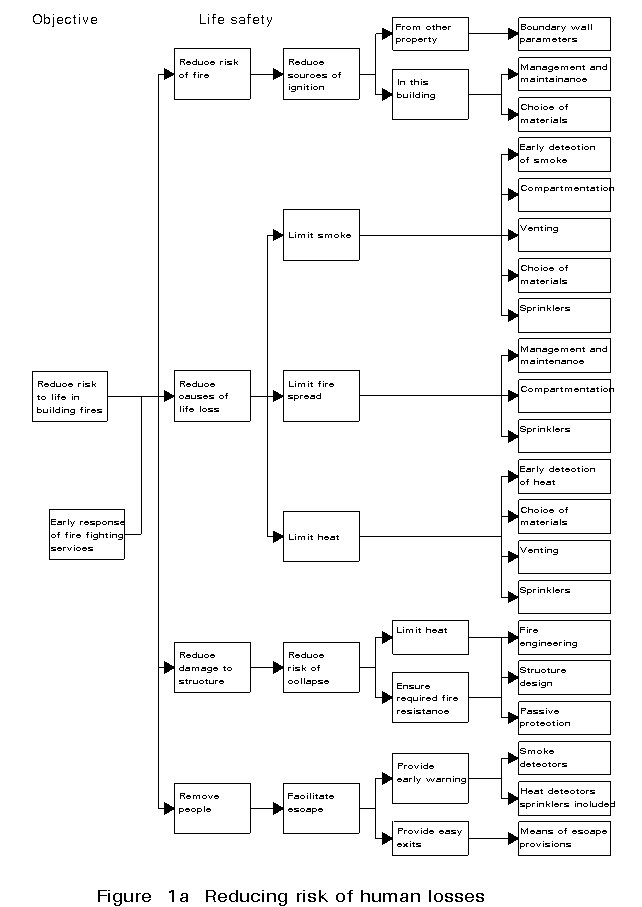
ESDEP WG 4B
PROTECTION: FIRE
To introduce the global approach to fire safety. To give an overview of assessment methods for the structural fire resistance of load-bearing elements.
None
Lecture 4B.2: Background to Thermal Analysis
Lecture 4B.3: Background to Structural (Mechanical Fire) Analysis
Lecture 4B.4: Practical Ways of Achieving Fire Resistance of Steel Structures
Fire losses, fire risk and the objectives of fire safety are described as background to the fire safety concept involving structural, monitoring and extinguishing concepts. Cost-effectiveness is discussed and an overview of assessment methods of structural fire resistance is presented. The effect of active fire protection is introduced.
An international survey of fire losses gives the following values:
Human fatalities: 4 to 34 fire fatalities per million head of population.
Financial losses: 1,6 to 5,9 0/00 of the Gross National Product per year.
In order to obtain an overall perspective of the risk of fire fatalities in buildings it is interesting to compare it with other accidental causes.
|
Activity |
Fatal accident rate per person and for an average life-time of 70 years. |
|
Motor cycling (UK) Scheduled flights (USA) Average for disease (USA) Travelling by car (USA) Travelling by car (UK) At home - average (excl, sickness) At home - total able bodied persons Fires in hotels (UK) Fires in dwellings (UK) Natural disasters (USA) |
4,1 1,5 0,7 0,6 0,4 0,02 0,01 0,01 0,001 0,0001 |
Table 1 Comparison of fatality statistics from different accidental causes. (Sources [1] [2] [3])
Although the risk of life loss in fire is quite low in comparison with other causes of death, there is a tendency for an incident involving multiple fatalities, over about 5 deaths, to attract a high level of news coverage. In this sense building fires tend to be regarded in the same high profile way as air crashes or earthquakes. Nonetheless it is important that the causes of fire fatalities should be examined with a view to public safety.
A breakdown of fatal casualties by fire location shows for Europe and USA that approximately 80 to 85% of all fatalities occur in domestic buildings (dwelling, flat) and only 10% in public buildings. On another hand about 95% of all deaths in buildings are due mostly to smoke or in very few cases to heat.
A survey on non-domestic fires in the Netherlands and France shows that the financial loss of the building content outweighs the cost of building damage [4].
|
Losses to building content |
43% |
) |
|
|
Consequential losses |
36% |
) |
4/5 |
|
Losses to building |
21% |
) |
1/5 |
The indication is that damage to content and consequential losses are more significant financial factors than damage to buildings.
The global cost of fire includes in Europe the following items:
(in 0/00)
|
2 - 5 |
|
0,2 - 3 |
|
0,3 - 2 |
|
1 - 3 |
|
1 - 3 |
|
0,1 - 0,5 |
|
2 - 5 |
and varies between 1,3 to 2,0% of the Gross National Product. The last item, e.g. the cost of fire safety measures in buildings represents as an average about 1 to 3% of the total building costs. In most countries a high investment in fire safety in buildings brings a reduction on direct, indirect and human losses, Still it is very important to analyze the cost-effectiveness or in other words the return of investment for each detailed fire precaution measure, see Section 1.5.
The usual way to measure the risk of fire is expressed by
Rfire = P x Lext
where
Rfire = Fire Risk
P = the probability of occurrence of a fire
Lext = probable extent of total losses.
Rfire < Raccepted
Raccepted represents the target risk which varies from country to country.
The risk R can never be zero and we have to accept a certain level of risk for every type of building and/or occupancy. This level will depend on the number of persons, their ability to escape and the value of content exposed to fire.
Table 2 gives some indications of the occurrence of fire in different types of building.
|
Type of building occupancy |
Source |
Number of fires per million m2 floor area per year |
|
INDUSTRIAL BUILDINGS |
United Kingdom [5] Germany [6] CIB W14 [7] |
2 2 2 |
|
OFFICES |
United Kingdom [5] USA [8] CIB W14 [7] |
1 1 0,5 + 5 |
|
DWELLINGS |
United Kingdom [5] Canada [9] CIB W14 [7] |
2 5 0,05 +2 |
Table 2 Occurrence of fire
The probable extent of losses varies for different occupancies and is a function of the degree of compartmentation, type of building, extent of automatic detection and extinguishing devices (Sprinkler/CO2/Halon), structural fire resistance and of the involved fire brigade.
The probability of fires getting out of control is strongly related to the type of active measures available, as indicated in the table below (reference CIB W14 Workshop "Structural Fire Safety" [7]).
|
Type of active measures |
Probability of fires getting out of control |
|
Public fire brigade |
100/1000 |
|
Sprinkler |
20/1000 |
|
High standard residential fire brigade combined with alarm system |
³ 10/1000 : 1/1000 |
|
Both sprinkler and high standard residential fire brigade |
³ 1/10.000 |
Table 3
Fire safety in buildings is concerned with achieving two fundamental objectives:
In most countries the responsibility for achieving these objectives is divided between government or civic authorities, who have responsibility for life safety via building regulations, and insurance companies who are concerned with property loss through their fire insurance policies.
Often the two objectives are thought to be incompatible, even occasionally conflicting. For example, sprinklers and automatic detection devices tend to be regarded as property protectors rather than life protectors and insurance companies will commonly offer substantial premium discounts when they are used. They do not figure highly in most national building regulations, yet the evidence that is available suggests that they are extremely effective in preserving life.
In fact the actions required to achieve life and property preservations are very similar.
Figures 1a and 1b use a systematic approach to identify the major options to reduce losses. They show that practically all options reduce the risk of human losses as well as the risk of financial direct and consequential losses. In fact we must realize that global fire safety must ultimately be answered by adequate fire safety concepts.

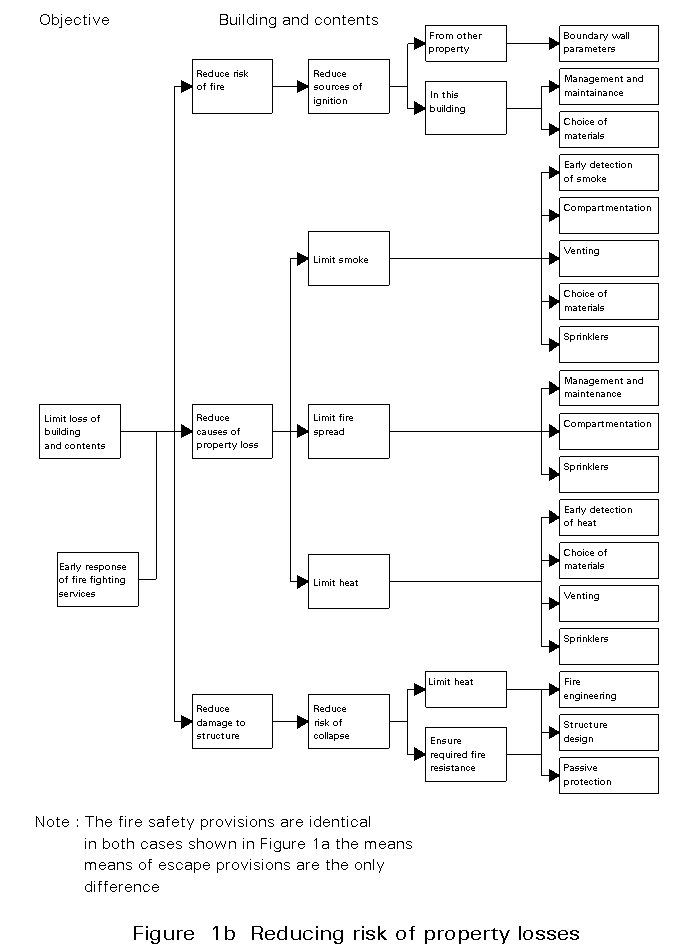
Fire safety concepts are defined as optimal packages of integrated structural, technical and organisational fire precaution measures which allow well defined objectives agreed by the owner, the fire authority and the designer to be fulfilled.
In order to develop possible fire safety concepts it is essential to show the usual development of an uncontrolled fire as shown in Figure 2.
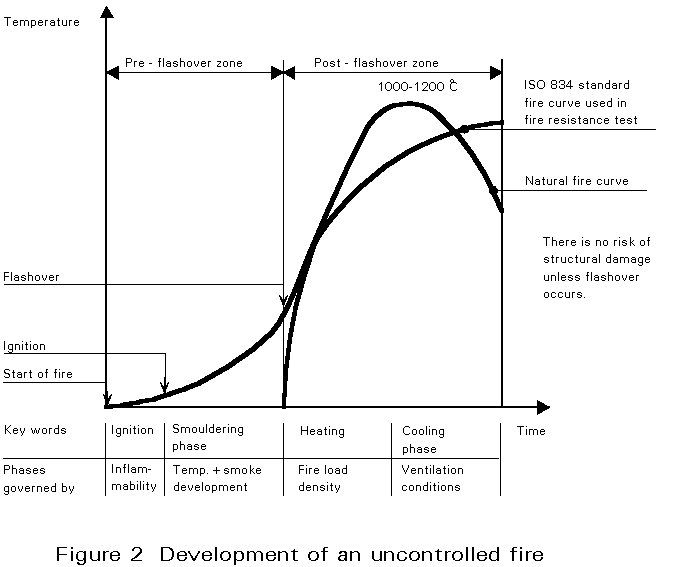
Another very similar presentation given as Figure 3 allows the reasons for success or failure of well-defined fire precaution measures to be visualised.
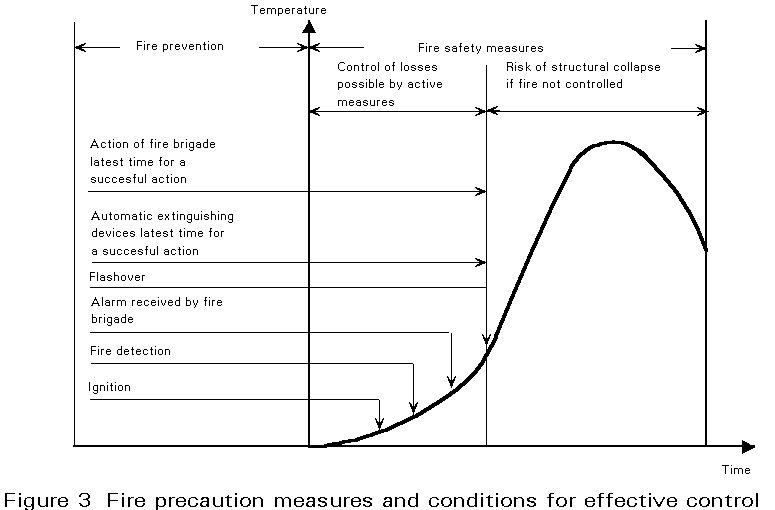
Analysing this figure we realize that we will be able to overcome the fire risk through three basic concepts which are:
A structural concept comprises compartmentation combined with an adequate fire resistant structure; it may be the best choice as long as the normal (cold-design) use of the building allows compartmentation by fire resistant floors and walls.
It is admitted that the fire may reach flashover conditions before fire fighting action begins.
The necessary time of fire resistance should be determined by the condition that the fire should not spread outside the fire compartment. Hence the separating and (possibly) load-bearing function of the relevant building components should be maintained during the anticipated duration of the fire.
Whenever possible fire spread should be limited by fireproof partition walls and floors. Combustible building components should be designed or treated to prevent fire spread by smouldering, eg. in two layer built-up roofs the combustible layer should be covered by a non-combustible one. The design of the facade should prevent flames climbing into an upper storey.
It is important to underline that all partition elements like walls, decks, ceilings and roofs (in some cases) must fulfil three criteria to be classified in a fire class (30/60/90...).
The load bearing structural elements with no partitioning function only have to fulfil the first criteria.
Fire resistance of the building components is usually prescribed in the building codes where it is normally expressed in units of time.
The required time for fire resistance is usually expressed in terms of multiples of 30 minutes: for example 30, 60, 90 minutes, related to ISO Standard fire. This means that a component is able to fulfil its function during the required time under a temperature exposure according to ISO.
Actual office buildings realized in London are excellent examples of this type of concept.
The time-temperature relationship in the standard fire may significantly differ from that in a real fire but modern fire design procedures allow fire resistance to be determined for natural fires as will be shown in paragraph 1.5. The time criterion should not be interpreted as an escape time for occupants or an intervention time for the fire brigade.
For structures and their occupancies it is often more effective to use alternative concepts based on the avoidance of FLASHOVER by means of non-structural active fire precaution measures. Active measures are based on a monitoring or an extinction concept.
The monitoring concept is based on automatic detection devices and automatic alarm transmission to an adequate fire brigade (around the clock), preferably to an on-site fire brigade.
A monitoring concept (shown in Figure 4) which involves limited or no structural fire resistance may represent the best choice when the normal (cold-design) use of a building calls for a minimum of compartmentation.
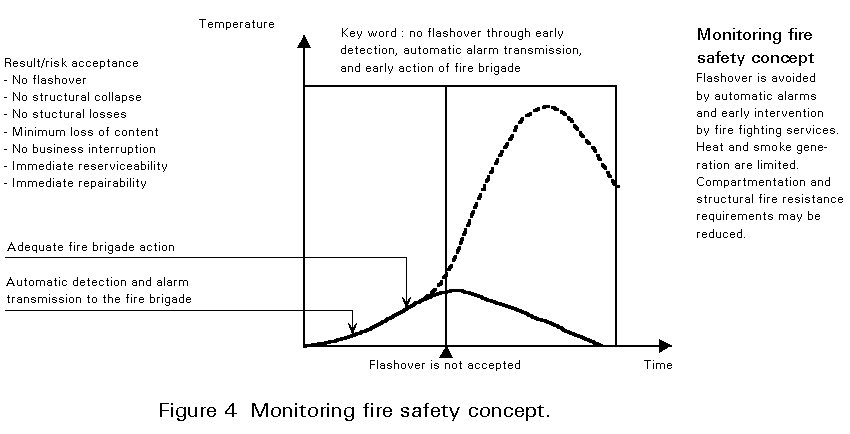
It is most applicable for occupancies with reduced fire load densities, for low to medium-rise buildings in which fires may be expected to develop slowly and where an effective and quick-responding fire brigade is available.
Automatic alarm systems are activated by smoke, heat or flames. They work mechanically or by electric or electronic systems. Preference is given to smoke detection, since this is, in general, by far the most effective way. When detectors begin to operate, an alarm is automatically set off. For maximum effectiveness, the alarm should be transmitted day and night to a nearby fire brigade station. Alarm systems with sound generating sirens are almost the only means against deliberate fires.
Sprinklers act as extinguishing devices and as a "slow" alarm system (heat detectors).
The effectiveness of fire fighting mainly depends on the time of arrival of the fire brigade and the access to fire.
The easiest means is the use of hand fire extinguishers, if there are people who detect the fire and who are skilled enough to use an extinguisher.
Fire fighting services may be either public fire brigades or works (on-site) fire brigades. Work fire brigades have the advantage of being acquainted with the locality and having shorter distances to reach the fire, but for all fire brigades it is essential to have access routes for their vehicles. For sprinklers as well as for fire brigades a sufficient water supply is necessary, and special precautions may be necessary in winter time. In a compartment the effective radius of action for firemen is up to 20 metres.
The extinguishing concept is based on automatic extinguishing devices such as sprinklers, CO2 or Halon-Systems with automatic alarm transmission to an adequate fire brigade and the owner. It is illustrated in Figure 5.
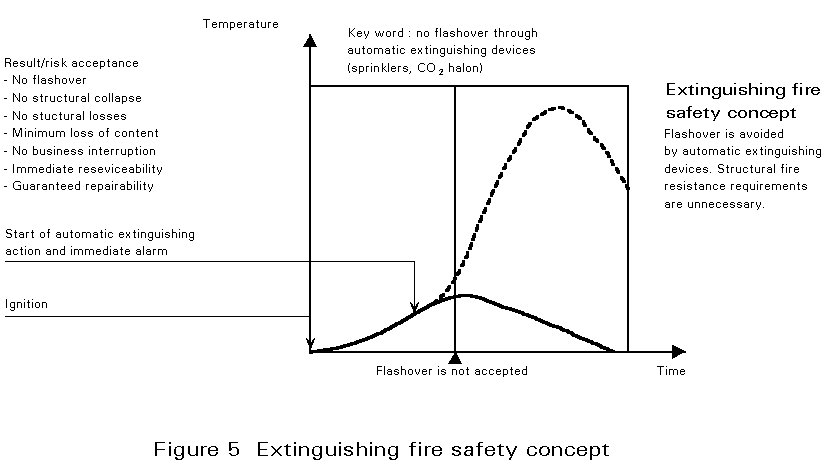
The extinguishing concept with limited or no structural fire resistance may represent the best choice when the normal (cold design) use of a building calls for a minimum of compartmentation. It is most applicable for occupancies with medium or high fire load densities and fast developing fires.
Building owners often are afraid of the damage which these systems may cause by the water poured on the stored material or the manufacturing machines. But sprinklers open their valves only at the spot where temperature reaches a critical limit of 70° to 140°C. It has to be noted that 75% of all fires in premises with sprinklers devices are controlled by 1 to maximum 4 sprinkler heads. This represents approximately 50 m2 watered by opened sprinkler heads. By means of an automatic alarm transmission system, they inform owner and fire brigade at once. It is important to know that automatic detection and extinguishing systems have to be maintained once or twice a year by specialists.
The alternative concepts of monitoring and/or extinguishing are gaining more and more acceptance in many countries. The brochure "Steel and Fire Safety: a global approach" edited by the Steel Promotion Committee of EUROFER, gives a survey how far these alternative concepts with no or reduced fire resistance requirements are internationally accepted.
The type of occupancy and the choice of the structural "cold-design" are the main variable governing the amount of fire protection measures necessary and thus the cost of the total FIRE SAFETY CONCEPT. The cold-design concept and the fire safety concept should be integrated from the beginning in order to obtain an optimum safety level with a minimum of investment. This aim can only be reached through a dialogue between the designers of a building and the fire authority at a very early stage of the planning.
An outline cost-benefit analysis indicates that the return on investment in fire precautions is variable.
Figure 6 shows that, as the expenditure level and therefore also the level of safety precautions is chosen higher, the loss expectation due to fire will decrease. This relation is indicated schematically by the broken line. The loss-expenditure curve has a hyperbolic shape which means that, beyond a certain point, there is little benefit in increasing the level of protection.
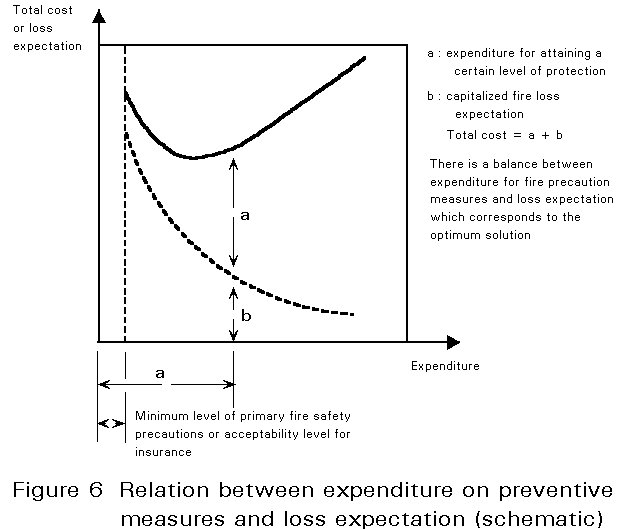
From the relation between expenditure and loss expectation it is possible to deduce the relation between expenditure and overall cost due to fire (= loss expectation + expenditure).
See the solid curve, the minimum of which corresponds to the optimum solution.
In this context it should be pointed out that in general the expenditure must not fall below a certain minimum, having regard to the requirements of life safety and/or the minimum level of acceptability for purposes of insurance. These aspects are also indicated in the figure.
Finally, attention must be drawn to the criteria by which the behaviour of the structure under fire conditions will have to be judged. In applying measures with a view to improving the fire safety of a building it will certainly be necessary to consider what the ultimate effect of such measures will be. It is known from experience that major building fires may damage the structure to such an extent that demolition of the building becomes necessary even though it has not collapsed. The money spent on protecting it from collapse will then have to be regarded as lost. In such a case it would be better either to limit the precautions merely to a level where escape of the occupants in the event of a fire is ensured, or to choose an alternative fire safety concept.
For a detailed cost-benefit-analysis a differentiated approach is necessary by calculating the annual costs of fire safety and trying to optimize them by comparison of different fire safety concepts. The basic formula is the following one:
Annual costs of fire safety =
[Sum of all investments for fire safety].[the mortgage rate in %]
+ [The repetitive maintenance costs per year]
+ [The annual premiums for the chosen fire safety concept (fire, acts of God, liability, business interruption)]
In most cases alternative concepts will show more cost-effective than structural concept.
For architects and engineers the crucial question consists in the definition of the level of fire resistance requirements they will have to fulfil, taking into consideration the global fire safety approach and the optimization of the cost-effectiveness of adequate modern fire safety concepts.
Fire Resistance is governed by two basic models:
which normally have three to four levels of sophistication.
Traditional methods of assessment are based on the standard fire curve as far as HEAT MODELS are concerned, but more quantitive methods are available based on natural fires.
Table 4 visualises the existing three assessment methods, where:
Felement is the fire resistance in minutes of the chosen element.
Frequired is the required fire resistance.
ASSESSMENT METHODS 1 and 2 are GRADING SYSTEMS
F-required and F-element are usually graded in catalogues or by calculation in FIRE-RESISTANCE CLASSES starting with 15 and 30 minutes and continuing by steps of 30/60/90...minutes
ASSESSMENT METHOD 3 (a + b) are ENGINEERING METHODS using models of real fire, the proof of the stability of the structure has to be shown.
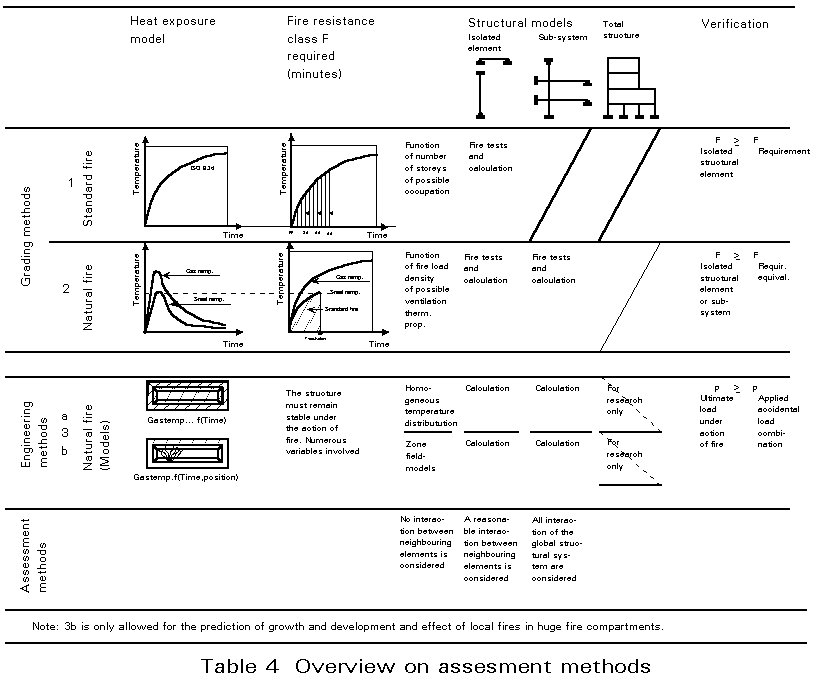
Each method is discussed below together with the improvements that a closer approach to reality will bring.
The term "Current Fire Resistance Requirements" is taken generally to mean the values fixed by NATIONAL CODES. They always use Fire Resistance classes (15/30/60/90...minutes) which represent the time an isolated element will resist the action of a STANDARD FIRE as defined by the heat exposure given by ISO-834. The level of requirements is a function of the number of storeys, and depending on the country, can be a function of the occupancy of the building and of the fire load.
The concept of equivalent or effective fire duration provides a first but important step towards a more differentiated approach. The equivalent fire duration (Te) is a quantity which relates a non-standard or natural fire exposure to the standard fire, in a way as is shown in Figure 7 and can be calculated if the fire load density and the ventilation conditions of the fire compartment are known.
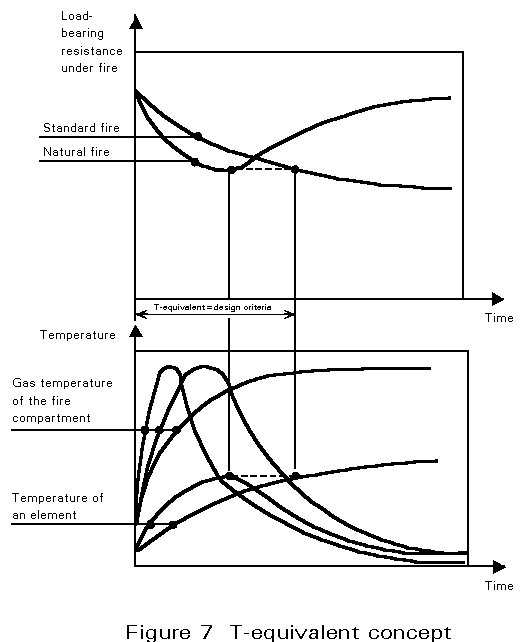
In more advanced concepts of the equivalent fire duration, the effects of the thermal properties of the building components surrounding the fire compartment are accounted for.
For current occupancies and their types of fire compartments, the T-equivalent concept gives a reasonable approach to the reality of fire.
Basically the value of the required fire resistance (Frequired) should be:
Frequired = g . Te
where g is a partial safety factor for model uncertainties. For normal cases g is often taken equal to one, due to the fact that a part of the fire load burns outside the fire compartment and that the combustion is never a total one.
Normal cases Frequired = Te for Te calculated on the assumption of a 100% combustion of all fire loads burning inside the fire compartment.
Currently Frequired is normally fixed at the next 15 or 30 minute step (15/30/60/90...)
This method is aimed to ensure that elements designed for g . T-equivalent will resist the action of a natural fire without collapsing even if no fire brigade action occurs.
This is the main feature of the T-equivalent concept.
An important advantage of this concept is that the tremendous amount of knowledge and data given by past fire testing can be used to verify the results of any calculation.
Many countries have already officially adopted this T-equivalent method in a more or less sophisticated way.
The design guide for Structural Fire Safety prepared by the CIB Workshop W14 [7] give the following formula for T-equivalent:
Te = c . w . qf
where c |
is a conversion factor accounting for the effect of the thermal inertia (heat absorption) of the fire compartment. |
|
where w |
is a ventilation factor accounting for all openings (windows, doors, gaps, skylights, fanlights) which allow heat to leave and fresh air to enter the fire compartment. |
| where qf | is the fire load density related to the floor area of the fire compartment. Appendix 1 of the design guide gives a detailed overview on evaluation, individual assessment and statistical values of fire load densities. |
The following table gives the range of the average values for the variable fire load density in MJ/m2 of some well-defined occupancies (combustion factor 1,0)
|
dwellings |
330 : 780 MJ/m2 |
|
hospitals |
100 : 330 MJ/m2 |
|
hotels |
310 : 330 MJ/m2 |
|
offices |
80 : 550 MJ/m2 |
(excluding files, storage, library and special rooms) |
|
schools |
215 : 340 MJ/m2 |
(excluding corridors, collection rooms, material, storage rooms) |
|
shopping centres |
400 : 900 MJ/m2 |
(excluding USA - figures) |
|
parking facility |
200 : 300 MJ/m2 |
The fixed fire load density (fixed to the building) for these occupancies varies between approximately 50 MJ/m2 (car park) and 450 MJ/m2 (rooms of teachers in a school).
Globally the total fire load density may be ranged in the following classes:
LOW |
less than 250 MJ/m2 (no flashover possible): |
car park |
|
MEDIUM |
500 to 1000 MJ/m2: |
dwellings, hospitals, homes, schools, offices, etc. |
|
HIGH |
1000 to 2000 MJ/m2: |
manufacturing and storage of combustible goods < 150 kg/m2 |
VERY HIGH |
more than 2000 MJ/m2: |
storage, warehouses |
These methods will only be introduced as a last and most sophisticated method of defining the correct level of Structural Fire Resistance.
Modern computer-assisted calculation methods are available which allow any Heat Exposure Model to be introduced.
In any case the reality of fire must be introduced through more or less simplified Heat Exposure Models. Two types of models are currently used:
All these engineering methods are based on an improved Heat Model in connection with an improved Structural Model. The verification consists in proving that the structure remains stable under the action of a real fire for the loads present at the time of the fire.
It is emphasized that with slight modifications Assessment Method 3 can also be used for buildings where only a limited time period, long enough to provide time for a safe escape and rescue, is required.
The interest in these engineering fire design methods will certainly be awakened by the new generation of Eurocodes [10, 11] introducing fire as an accidental situation.
This method applies for fire compartments of a size usually found in hotels, offices, schools, dwellings, etc. with an equal distribution of the fire load. The assumption of a uniform distribution of temperature in the fire compartment is then correct. This method introduces the following main variables:
Some variables may be approximated or even ignored. Two variable will always have a strong influence.
The influence of fire load density and ventilation of compartment gas temperature is illustrated in Figures 8a and 8b. They correspond to a simplified compartment fire theory as a basic heat exposure model for engineering fire design. Current compartment fire theories neglect the pre-flashover period, the structural response being mainly governed by post flashover temperature evolution.
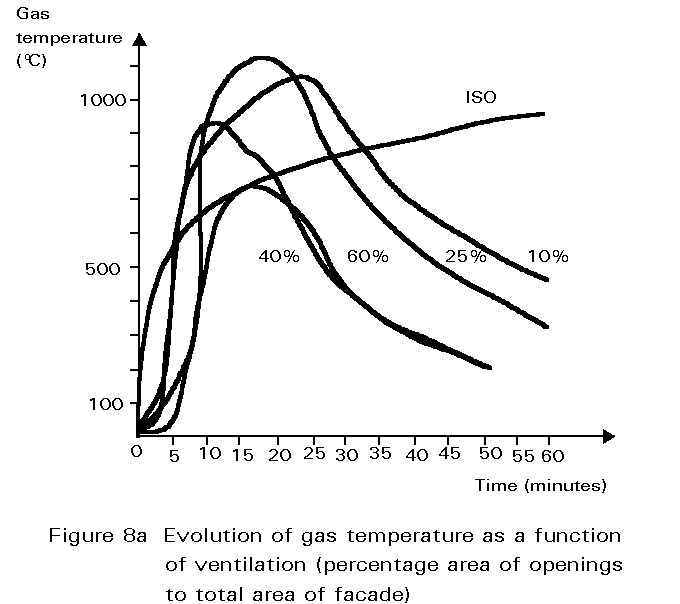
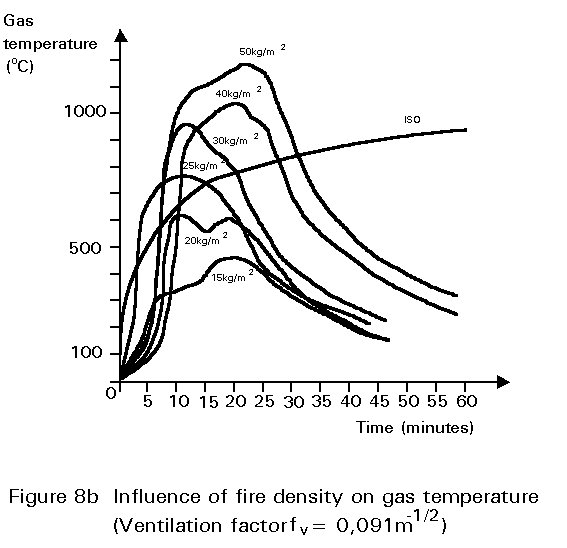
These methods try to evaluate the evolution of fire as a non-uniform problem where for a given compartment and a known localized fire load temperature will be governed by
Therefore the temperature evolution will be a function of:
These methods must be calibrated. International tests have been carried out either in large fabrication halls (CTICM France...) or in test facilities with large compartments (Finland/Espoo) which allowed the temperature evolution of natural fires to be measured at different points. These methods are useful for all cases of localized fire in large compartments or large spaces.
If it is possible to avoid the occurrence of any flashover situation by means of adequate active measures (automatic detection, adequate fire brigade, sprinklers; CO2, Halon), the structure will never be endangered by fire.
So independently of any assessment method the fire resistance requirements may be reduced or mostly zero rated, as long as the probability of success of the active measures is high enough.
In fact an increasing number of countries like Sweden, Switzerland, and Germany allow for reduced or no Fire Resistance Requirements when the probability of avoiding flashover or of localising a fire in a small area is high enough. Some other countries are moving to this direction. These alternative concepts will normally be limited to occupancies which will not undergo significant change of use and to buildings with a limited number of storeys. The major argument brought forth against these Alternative Concepts refers to the reliability of the active measures in the sense that, if they fail to suppress an initial fire, then a reduced fire resistance of the structure could exhibit a considerable hazard. We should however consider the risks of failure case by case.
The fire modelling assessment method is an appropriate way to prove the effectiveness of alternative fire safety concepts. In fact the dependency of structural fire requirements on potential structural hazards is uncritically accepted whilst the dependency on non-structural measures (governing the frequency of severe fires) is often not generally acknowledged as a design parameter. Fire modelling will ultimately allow the influence of extinguishing actions (automatic devices such as Sprinklers and fire brigade actions) to be quantified and incorporated into the assessment.
For the Assessment Method 2 (T-equivalent-method), the CIB Design Guide for Structural Fire Safety proposes to multiply the value of te given under point 2.2. of this paper by a differentiation factor accounting for special fire-fighting provisions (active measures). This differentiation factor will vary in function of the safety level, effectiveness and liability of the chosen special fire-fighting provision and is always lower than the unity.
[1] Kletz T.A., Symposium on Loss Prevention in Chemical Industry - Inst. Chem. Eng., Newcastle on Tyne, 1971.
[2] Sowby F.D., Symposium on Transporting Radioactive Materials, April 1964.
[3] Fry J.F., Inst. Fire Eng. Edinburgh (1970) 30 77.
[4] Field Survey on the Role of Steel Structures in Industrial Fires. Evaluation of European Research carried out in France and in the Netherlands. ECSC-Agreement Number: 7219-SA-307 & 607.
[5] Baldwin R. and Thomas P.H., Passive and active fire protection - the optimum combination. Fire Research Station. Fire Research Note Number 963, London, 1973.
[6] DIN 18 230 : Baulicher Brandschutz im Industriebau. Teil I : Rechnerisch erforderliche Feuerwiderstandsdauer. Deutsches Institut für Normung e.V., Berlin.
[7] CIB (Conseil International du Bâtiment) W14 Workshop "Structural Fire Safety": A Conceptional Approach Towards a Probability Based Design Guide on Structural Fire Safety. Fire Safety, Volume 6, Number 1, 1983. Elsevier Sequoia S.A., Lausanne.
[8] Wiggs, R., BOMA International Office Building, Fire Survey, Skyscraper Management, 58 (6), 1973.
[9] Lie, T. T., Safety Factors for Fire Loads, Canadian Journal of Civil engineering, Vol 6, No. 4, December 1979.
[10] Eurocode 1: "Basis of Design and Actions on Structures": Part 2.7: Actions on Structures Exposed to Fire, CEN (in preparation).
[11] Eurocodes 2-6: "Design of Concrete, Steel, Composite, Timber and Masonry Structures": Parts 10: Structural Fire Design, CEN (in preparation).